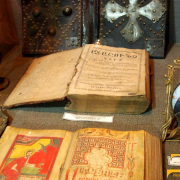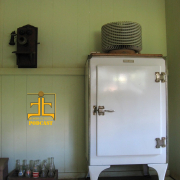Historical Context
Roots of Armodoxy: Historical Context
Recently I read a post on social media which said, “Don’t ever say, ‘Bible-reading is for monks; am I making my child a monk?’ No! It isn’t necessary to make him a monk. Make him a Christian!” The quote was placed atop a graphic of St. John Chrysostom, a giant of the Christian Church who lived in 4th century. (347-407AD).
Like many pronouncements made by the beloved saint, the statement is simple and profound. But something bothered me about it. Of course, it is the admonishment we expect, especially parents or anyone concerned with the Christian upbringing of a child. But something was off, and it was as simple as the date of the quote.
The Bible wasn’t put together until the 5th century? Even more, Bibles weren’t readily accessible by the people until the advent of the printing press in the 15th century. What did the words, “Bible-reading” mean in this case? Here is a saint of the Church, of the 4th century, admonishing people to have their children read the Bible, before the Bible was put together in the form we refer to as Bible and during a time when literacy was not common.
When I was first ordained a priest, an elderly parishioner of mine brought a hand-written letter for me read to her. This was 1982. I did. It was personal in nature. She thanked me and went off. She was a survivor of the Genocide and had traveled through refugee camps and made her way to America where she formed her family. I wondered why did she bring this letter to me? It was sometime after this reading that I learned that the in the old-country, priests would be the learned members of a village. It was common for people to bring written documents to the priest for reading, knowing that they would have confidentiality and a fair interpretation of the words. This episode was just a few years back, and literacy was not common. And so, I had to find out what was the source of the quote attributed to St. John Chrysostom? What did he mean when he said, have your children “read the Bible”?
I found an article, “Eight Quotes from St. John Chrysostom on How to Raise Children” and the original to the quote in question was there: “Never deem it an unnecessary thing that he should be a diligent hearer of the divine Scriptures.”
“Bible-reading” was loosely translated in that post from the words, “diligent hearer of the divine Scriptures.” And while this may seem like a mere 21st century upgrade to the words, Chrysostom’s words mean so much more than reading the Bible. Holy and Divine Scripture have a place in the Church. The Scriptures are a tool of the Church. The words of the saint are a call to attend the Body – the church – the Community, the Corporate Worship of the Church, where the “diligent hearing of divine Scriptures” becomes possible.
Historical context is essential to understanding instruction in all walks of life, especially in the spiritual instruction in the Christian Church.
Since the Protestant reformation we have deviated from the original intention of Holy Scriptures in the Church. Granted that the abuse of those Scriptures was cited as one of many reasons for the reform, still the outcome of the reformation, some 500+ years later is that the free reign on translating and interpreting the words of Holy Scripture has led to much anguish among those who are oppressed in the name of an interpretation, or excluded because of the intolerance which has been justified by a personal understanding of the Scriptures.
In the Armenian Church, Holy Scriptures are referred to as the Breath of God. It is sacred. The Church shares the Gospel through that Breath. It is in a historical context – the long history of the Christian Church – that the Scriptures come alive.
We end today with a meditation on this topic which comes from the Sermon on the Mount. It is the lectionary reading for the feast of the Holy Translator (the Translators of the Bible) and Jesus instructs us, “Do not give dogs what is sacred; do not throw your pearls to pigs. If you do, they may trample them under their feet, and turn and tear you to pieces.”
We continue with more roots of Armodoxy tomorrow. Join us at epostle.net



 2025 Fr Vazken
2025 Fr Vazken
 2023 Fr Vazken
2023 Fr Vazken




 2014 Fr Vazken
2014 Fr Vazken
Leave a Reply
Want to join the discussion?Feel free to contribute!